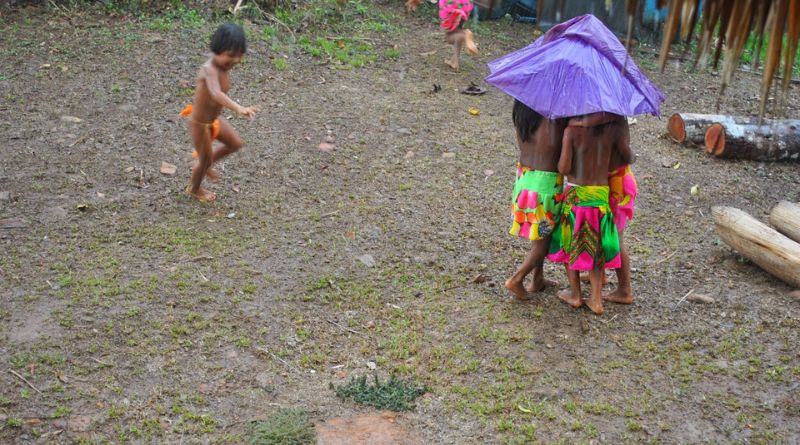The Embera people, one of the most fascinating indigenous groups of Panama and Colombia, have a rich cultural heritage that has been passed down through generations. The traditional attire worn by the Embera, particularly their loincloths, serves as an important part of their identity and daily life. This article will focus on the Embera loincloth tribe kids, exploring their way of life, the role of clothing, and how children are brought up within this vibrant community.
Table of Contents
Who Are the Embera Tribe?
The Embera tribe is an indigenous group that primarily resides in the rainforests of Panama and Colombia. They speak the Embera language, which belongs to the Chibchan language family, and have maintained much of their traditional lifestyle despite influences from the outside world. The Embera people are known for their intricate body art, vivid clothing, and close connection to nature. They live in communal huts called “rancherías” and sustain themselves through agriculture, hunting, fishing, and crafting.
The Role of Clothing in Embera Culture
Clothing plays a significant role in Embera culture, symbolizing identity, status, and community cohesion. The Embera loincloth is a traditional garment worn by both adults and children. Made from the fibers of local plants, the loincloth is often decorated with elaborate patterns and colors. These garments are simple yet practical, designed to suit the hot, humid climate of the rainforest.
Children in the Embera tribe typically wear loincloths from a young age, often starting at the age of five or six. The garments are tied around the waist and worn as part of their daily attire. The Embera loincloth is more than just clothing; it is a symbol of the tribe’s respect for nature, tradition, and their ancestors.
Embera Loincloth Tribe Kids: A Day in the Life
The daily lives of Embera loincloth tribe kids are shaped by the natural environment and the cultural values passed down from their elders. Children begin their day at dawn, helping with various household chores such as fetching water from nearby streams, gathering firewood, or assisting in the cultivation of crops like cassava and plantains. They learn these skills from their parents and elders as part of their education in survival and self-sufficiency.
In addition to domestic chores, the children also spend time playing games, exploring the rainforest, and learning important survival skills. The Embera tribe places a strong emphasis on physical endurance, hunting, and the knowledge of local plants and animals. Boys, for example, are taught how to fish, hunt small game, and navigate the forest from an early age. Girls often assist their mothers in tasks related to food preparation, weaving, and crafting.
The Embera tribe is a matrilineal society, meaning that children inherit their identity and heritage from their mothers. This structure influences the roles that boys and girls play within the community. However, both genders are expected to contribute to the tribe’s well-being, making children’s involvement in community work an integral part of their upbringing.
The Significance of Body Art for Embera Kids
A striking feature of the Embera tribe’s cultural identity is their use of body art, particularly the application of tattoos and paint. Traditional body paint is made from natural dyes derived from plants, such as annatto seeds and various types of clay. For children, body art serves as both a form of decoration and a rite of passage.
As young Embera children grow, they begin to adorn themselves with intricate patterns that hold cultural significance. The patterns are often symbolic, representing family ties, achievements, or milestones. For example, as children enter adulthood, they may receive more elaborate body tattoos as a symbol of their growth and readiness to take on adult responsibilities. These tattoos can also act as a connection to their ancestors, reinforcing the community’s deep sense of heritage.
Learning and Education in the Embera Tribe
In the Embera tribe, education is informal and hands-on. Children learn not through textbooks or classrooms, but by being immersed in the daily activities of their community. The tribe places high value on practical knowledge, such as hunting techniques, plant identification, and crafting skills. The ability to survive in the jungle, make tools, and respect the natural world is considered essential.
Formal schooling is less common in the Embera community, although some tribes have been in contact with the government and educational organizations. The introduction of formal education, however, is often met with resistance, as the tribe wants to preserve its way of life. Embera children are thus educated in a unique manner that strengthens their bond with their culture.
The Role of Family in Raising Embera Kids
Family plays a central role in the upbringing of Embera children. The extended family unit is crucial, with grandparents, aunts, uncles, and cousins all contributing to the raising of children. Children often live in close-knit communities where the concept of “village parenting” is prevalent. It’s not uncommon for children to be raised by multiple caregivers who provide guidance, discipline, and love.
The Embera tribe places great importance on communal responsibility. Children are taught early on to respect elders and the wisdom they offer. They also learn the value of cooperation and sharing, as their way of life depends on mutual support and collaboration. These values help ensure that the tribe remains united and strong, even in the face of external pressures.
Challenges Facing the Embera Tribe
Despite the Embera tribe’s rich cultural heritage, the community faces numerous challenges. Modernization, deforestation, and climate change have threatened the tribe’s way of life. Many Embera people have been displaced from their ancestral lands due to logging and agricultural expansion. As a result, some families have been forced to migrate to urban areas, where they often struggle to adapt to a radically different lifestyle.
The introduction of Western education and technology also presents challenges for Embera children. While the tribe has embraced some aspects of modern life, they are determined to preserve their traditions. The balance between maintaining cultural practices and adapting to the outside world remains a delicate issue for the Embera tribe.
Embera Loincloth Tribe Kids: Preserving Tradition
As the world changes around them, the Embera loincloth tribe kids continue to play a crucial role in preserving their culture. Through their clothing, body art, and way of life, they maintain a strong connection to their ancestors and the natural world. The younger generation is taught to value their heritage, pass down traditional skills, and respect the natural environment that sustains them.
Though the Embera people face many challenges, they remain resilient, holding onto their customs while adapting to the modern world. Their children, with their bright spirits and unwavering connection to their traditions, are the future of the Embera tribe. By understanding and respecting the significance of Embera loincloth tribe kids, we can gain a deeper appreciation for the strength and beauty of indigenous cultures and the importance of cultural preservation.
FAQs About Embera Loincloth Tribe Kids
Q1: What is the significance of the loincloth in Embera culture? The loincloth is an important part of Embera identity, symbolizing connection to nature, tradition, and community. It is made from plant fibers and is worn by both adults and children.
Q2: At what age do Embera children start wearing loincloths? Children in the Embera tribe typically begin wearing loincloths at the age of five or six. This garment is a traditional and practical attire for the hot, humid climate of the rainforest.
Q3: Do Embera children attend formal schools? Formal schooling is not widespread in the Embera community. Children typically learn through hands-on experiences, participating in daily chores and cultural practices within the tribe.
Q4: How do Embera children learn survival skills? Embera children learn survival skills from their parents and elders. Boys are often taught hunting, fishing, and navigating the rainforest, while girls assist with food preparation and crafting.
Q5: What role does family play in raising Embera children? Family plays a central role in the upbringing of Embera children. The extended family helps raise children, offering guidance and teaching important cultural values.



